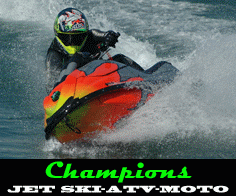Exploring the roots in the history of Jet Skis we cooperated exclusively with Clayton Jacobson II, the Jet Ski Inventor in order to put the historic records in order with the scope to present the first stand ups ever made before Kawasaki released it officially in the market in 1973.
Words:Vasilis Moraitis
Source: Clayton Jacobson II, The Jet Ski Inventor
Photos:www.jetskiworld.gr, Rusty Sharman
Having read the book released by Clayton Jacobson II, the one and only Jet Ski Inventor I decided to put the records of stand-up history in an order in order to find out how many skis were actually made before Kawasaki released officially in the market the first stand-ups, WSAA and WSAB, in the market.
Since Jacobson and I were met in Havasu last year at Jetrrim’s Vintage Jet Ski museum I managed to contact him in Australia and send him a lists of questions while I kept referring back to his book and some notes I had made through Bob Phares. In order to keep the Vintage philosophy as raw as possible I decided to leave Jacobson’s answers untouched as they were replied to my questions.
Initially I wanted to found out what were those boats featured in a photo of Rusty Sharman published in Vintage Jet Ski on FB, since there were some unknown skis pictured in this particular photo which was taken back in 1972.
According to Clayton Jacobson II: “The first boat in the foreground CF0299MB is registered to Jacobson Engineering, a “Kamola”. 1971 prototype Jet Ski, as built, one of the four.
The next one back of CF4126 EX is registered to Kawasaki Motors USA one of 12 built in Japan as set out in the book page 116. Carved and shaped by Jacobson in Japan, except for the handle pole which was enlarged too much for floatation after I had returned home. The geometry was corrected as shown in the page 117 D 19 but overblown in my absence, see D21 page 117.
The one at the back CF 4127 may be one of the first production Jet Skis made by KHI (Kawasaki Heavy Industries) in Japan with the floatation corrected.
Note: The exact identical geometry is in all three versions, fully explained technically in the Jacobson patents. The handle bars (top) must rotate in a horizontal plane (horizontal axis) for stability in operation, mandatory.”
JetSkiworld.gr: I guess that Kamola was the first prototype you worked for Kawasaki in 1972. In the photo of Rusty Sharman at Snug Harbor you can see another two prototypes and one of them seems to have a thicker handle pole.
Clayton Jacobson II: It is incorrect to say, “you worked for Kawasaki in 1972”. Jacobson Engineering Co. licensed Kawasaki to his invention and provided Consultant and Engineering services to Kawasaki.
Rusty Sharman to my knowledge was the worlds first “Jet Skier” not just in the exposure to or other association like CJ3, I mean as a true “affecionado” one who loved the sport for the sport. There were others with experience prior but not the heart or skills. The Kawasaki people were knee riders dedicated to their paychecks which retarded progress immensely for years, page 231 in the book. See Rusty Sharman “After a day of hard riding”for answer that discuss the different handle poles.
Jetskiworld.gr: How many prototypes were you testing at the same time and what were the main differences among those boats?
Clayton Jacobson II: The Kamola had three prototypes, which were tested all over America and Mexico extensively. Satisfactory except for electronics and adding top/side loatation for self-righting.
Twelve (12) “powered water ski’s” Kawasaki Heavy Industries (KHI) built in Japan and shipped to America 1972 Snug Harbor. Kawasaki Motors Corporation KMC extensively experimented to design around the “Jacobson Footprint”. All of these failed, generally conventional bottoms, deeper V’s etc., numerous. This made the B of A + B (referred as WSAA and WSAB), which was dropped, all came to nothing.
JetSkiWorld.gr: The Kamola also seems to have a peculiar expansion chamber. When did you change that to the standard wet pipe we saw later in the production units of WSAA and WSAB?
Clayton Jacobson II: Not Kamola, wrong, wrong, wrong. The photo you refer to is a very early KHI exhaust system. I refused to use when I marinized the snowmobile engine originally. The standard wet pipe is my design as built. In the Kamola’s (adverse to KHI wishes) at the time the system came from the 1968 Red Boat, wet pipe, water box and muffler.
JetSkiWorld.gr: I read in your book that actually 12 prototypes were used for testing before Kawasaki released the legendary WSAA/WSAB units.
Clayton Jacobson II: Correct as above the 12 stand-up Jet Skis were extensively endurance tested until the riders knees were so bloody they had to quit. In the book page 231 etc.
The snowmobile engine boat
The particular stand-up was featured in Jettrim’s Vintage Jet Ski Museum last year and actually it was a pole of attraction with all its weird and prototype craftsmanship. The 500cc snowmobile engine was marinized in such a way in order to produce a very fast stand-up. Worth noting features were: the rope start system, the slide type carburetors and the kevlar reinforced hull.
JetSkiWorld.gr: I believe that you do have a record of your Allien hulls/skis, I mean which is 1st 2nd etc. Therefore, where in that order would you place the Red boat with the snowmobile Yamaha engine and the external exhaust (the one we saw in Havasu last October)?
Clayton Jacobson II: In the book pages 286-287 the Alien”(note spelling (1 of 1) was built 1981. Alien was what Kawasaki people named it in a “degrading way”. It stuck and we became proud of it. There is/was only one “Red Boat” that was 1968 fixed hull. In the book pages 79, 93 and 109.
JetSkiWorld.gr: Why did you decide to use an external exhaust system in this boat?
Clayton Jacobson II: 30% increase in horse power.
JetSkiWorld.gr: In general which aspects where you evaluating with this part of evolution? Which were the things and ideas that you were looking for?
Clayton Jacobson II: Hull designed for surfing extremely light weight high strength practically indestructible Kevlar construction. You could bounce the hull up against reefs, it was rock proof, very high performance.
JetSkiWorld.gr: How was the performance of this engine with the motorcycle type of carburators? Why was those slide type carbs was ditched later on?
Clayton Jacobson II: Excellent, who ditched them? Where? When? This was “El Tigre”world champion engine.
JetSkiWorld.gr: Was it reasonably easy to fire up this engine with the pull-cord ignition system?
Clayton Jacobson II: Not in the water.
JetSkiWorld.gr: Rating the hull of this boat what differences did it have compared to the previous Allien hulls? Chines, pump tunnel, tray width, bond flange, etc.
Clayton Jacobson II: There were no previous Alien hulls.
JetSkiWorld.gr: What were the issues arise in this craft and did it help you to evaluate and test the next Allien unit?
Clayton Jacobson II: In the book pages 283, 1985 World Finals we went too fast and IJSBA barred the exhaust system for ever.
Yamaha SuperJet
Clayton Jacobson was also licensed by Yamaha to put his valuable input for the creation of the first SuperJet. As mentioned in to his book, the Yamaha project was most straight forward since he already had the experience from his earlier creations and designs which were had been endurance tested and evaluated.
JetSkiWorld.gr: I would be also interested to make a story on the first Yamaha SuperJet you designed. That is something you have not revealed much in your book.
Clayton Jacobson II: Yamaha picked and chose the technology that I presented. Yamaha follows the rules pretty much, a very honorable company, conservative. They kept their agreement with me in every way, still keeping those secrets which they do not use.
NOTE: This story would not have been written if I had not had the chance to meet Clayton Jacobson II and also if I had not read his autobiography “Jet Ski Inventor Autobiography”.
Many thanks to Gary Hart from Jettrim who kept listening to me when I was telling him over and over again “try to bring Clayton at Jettrim Vintage Jet Ski Museum”.













